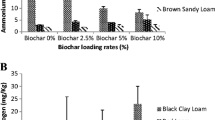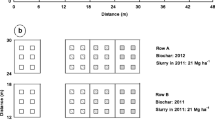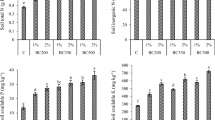Abstract
Biochar as an organic amendment improves soil attributes, with a potentially significant effect on soil chemical fertility and quality. The main objective of this study was to quantify the effect of biochar addition on nutrients, carbon sequestration and microbial activity and understand the mechanisms of controlling biochar effects in calcareous soils. Maize residue biochars produced at 200, 400 and 600 °C were added at 5 and 10 g kg−1 rates to sandy loam and clayey texture calcareous soils. The soil properties measured were pH and electrical conductivity (EC), plant-available potassium (K) and available phosphorus (P), total nitrogen (TN), C sequestration; and the fluorescein diacetate (FDA) hydrolysis activity. Addition of raw material and biochars increased pH (0.15–0.46 units), EC (0.14–0.38 dS m−1), TN (63–120%), K (12–41%) and FDA activity (27–280%), but tended to decrease plant-available P (23–86%). Increasing pyrolysis temperature increased soil C pool index (CPI), but decreased the FDA and the changes depended largely upon the application rate and soil texture. The positive effects of biochar addition and its pyrolysis temperature on soil C sequestration potential were more pronounced at high than low application rate and in sandy loam than clayey soils. Nevertheless, the effect of biochar addition and pyrolysis temperature on the FDA activity was higher at high than low application rates, but lower in sandy loam than clayey soils. Although biochar application may successfully improve soil processes and attributes and have a high potential for C sequestration, its effects are controlled by soil texture, pyrolysis temperature and application rate.




Similar content being viewed by others
References
Alef K, Nannipieri P (1995) Methods in applied soil microbiology and biochemistry. Academic Press, London, pp 214–216
Backer RGM, Schwinghamer TD, Whalen JK, Seguin P, Smith DL (2016) Crop yield and SOC responses to biochar application were dependent on soil texture and crop type in southern Quebec, Canada. J Plant Nutr Soil Sci 176:399–408
Bhaduri D, SahaA Desai D, Meena HN (2016) Restoration of carbon and microbial activity in salt-induced soil by application of peanut shell biocharduring short-term incubation study. Chemosphere 148:86–98
Bremner JM (1996) Nitrogen total. In: Sparks DL (Ed.), Methods of Soil Analysis. Part 3. America Society of Agronomy, SSSA Book Series, Madison, pp. 1085–1121
Calderón FJ, Benjamin J, Vigil MF (2015) A comparison of corn (Zea mays L.) residue and its biochar on soil C and plant growth. PLoS ONE 10 (4): e0121006. https://doi.org/10.1371/journal.pone.0121006
Chintala R, Schumacher TE, Kumar S, Malo DD, Rice JA, Bleakley B, Chilom G, Clay DE, Julson JL, Papiernik SK, Gu ZR (2014a) Molecular characterization of biochars and their influence on microbiological properties of soil. J Hazard Mater 279:244–256
Chintala R, Schumacher TE, Kumar S, Malo DD, Rice JA, Bleakley B, Chilom G, Clay DE, Julson JL, Papiernik SK, Gu ZR (2014b) Molecularcharacterization of biochars and their influence on microbiological properties of soil. J Hazard Mater 279:244–256
Demisie W, Liua Z, Zhang M (2014) Effect of biochar on carbon fractions and enzyme activity of red soil. CATENA 121:214–221
Du ZL, Zhao JK, Wang YD, Zhang QZ (2017) Biochar addition drives soil aggregation and carbon sequestration in aggregate fractions from an intensive agricultural system. J Soils Sediments 17:581–589
Elzobair KA, Stromberger ME, Ippolito JA, Lentz RD (2016) Contrasting effects of biochar versus manure on soil microbial communities and enzyme activities in an Aridisol. Chemosphere 142:145–152
Enders A, Hanley K, Whitman T, Joseph S, Lehmann J (2012) Characterisation of biochars to evaluate recalitrance and agronomic performance. Bioresource Technology 114:644–653
Galvez A, Sinicco T, Cayuela ML, Mingorance MD, Fornasier F, Mondini C (2012) Short term effects of bioenergy by-products on soil C and N dynamics, nutrient availability and biochemical properties. Agric Ecosyst Environ 160:3–14
Gee GW, Bauder JW (1986) Particle size analysis. In: Klute A (ed) Methods of soil analysis, Part 1. American Society of Agronomy, Physical and mineralogical methods, pp 383–411
Green VS, Stott DE, Diack M (2006) Assay for fluorescein diacetate hydrolytic activity: optimization for soil samples. Soil Biol Biochem 38:693–701
Ippolito JA, Novak JM, Busscher WJ, Ahmedna M, Rehrah D, Watts DW (2012) Switchgrass biochar affects two Aridisols. J Environ Qual 41:1123–1130
Khadem A, Raiesi F (2017) Responses of microbial performance and community to corn biochar in calcareous sandy and clayey soils. Appl Soil Ecol 114:16–27
Khadem A, Raiesi F (2019a) a. Response of soil alkaline phosphatase to biochar amendments: Changes in kinetic and thermodynamic characteristics. Geoderma 337:44–54
Khadem A, Raiesi F (2019b) b. Short-term effects of maize residue biochar on kinetic and thermodynamic parameters of soil β-glucosidase. Biochar 1:213–227
Lee JW, Kidder M, Evans BR, Paik S, Buchanan AC, Garten CT, Brown RC (2010) Characterization of biochars produced from corn stovers for soil amendment. Environl Sci Technol 44:7970–7974
Lehmann J, Czimczik C, Laird D, Sohi S (2009) Stability of biochar in the soil. In: Lehmann J, Joseph S (eds) Biochar for environmental management: Science and Technology. Earthscan, London, pp 183–205
Lehmann J, Rillig MC, Thies J, Masiello CA, Hockaday WC, Crowley D (2011) Biochar effects on soil biota-A review. Soil Biol Biochem 43:1812–1836
Liang C, Gascó G, Fu S, Méndez A, Paz-Ferreiro J (2016) Biochar from pruning residues as a soil amendment: Effects of pyrolysis temperature and particle size. Soil Tillage Res 164:3–10
Luo S, Wang S, Tian L, Li S, Li X, Shen Y, Tian C (2017) Long-term biochar application influences soil microbial community and its potential roles in semiarid farmland. App Soil Ecol 117–118:10–15
Masto ER, Kumar S, Rout TK, Sarkar P, George J, Ram LC (2013) Biochar from water hyacinth (Eichornia crassipes) and its impact on soil biological activity. CATENA 111:64–71
Masto ER, Ansari MA, George J, Selvi VA, Ram LC (2013) Co-application of biochar and lignite fly ash on soil nutrients and biological parameters at different crop growth stages of Zea mays. Ecol Eng 58:314–322
Mukherjee A, Zimmerman AR (2013) Organic carbon and nutrient release from a range of laboratory-produced biochars and biochar–soil mixtures. Geoderma 193–194:122–130
Naeem MA, Khalid M, Aon M, Abbas G, Amjad M, Murtaza B, Khan W, Ahmad N (2018) Combined application of biochar with compost and fertilizer improves soil properties and grain yield of maize. J Plant Nutrit 41:112–122
Nelson DW, Sommers LE (1982) Total carbon, organic carbon and organic matter. In: Page AL, Miller RH, Keeney DR (Eds) Methods of soil analysis. Part 2. Chemical and microbiological properties. American Society of Agronomy, pp. 539–577
Nielsen S, Minchin T, Kimber S, van Zwieten L, Gilbert J, Munroe P, Joseph S, Thomas T (2014) Comparative analysis of the microbial communities in agricultural soil amended with enhanced biochars or traditional fertilisers. Agri Ecosyst Environ 191:73–82
Oliveira FR, Patel AK, Jaisi DP, Adhikari S, Lu H, Khanal SK (2017) Environmental application of biochar: Current status and perspectives. Bioresour Technol 246:110–122
Olsen SR, Sommers LE (1982) Phosphorus. In: Page AL, Miller RH, Keeney DR (eds) Methods of soil analysis, Part 2, Chemical and microbiological properties. American Society of Agronomy, Madison, WI, pp 403–430
Ouyang L, Yu L, Zhang R (2013) Effects of biochars derived from different feedstocks and pyrolysis temperatures on soil physical and hydraulic properties. J Soils Sediments 13:1561–1572
Ouyang L, Yu L, Zhang R (2014) Effects of amendment of different biochars on soil carbon mineralisation and sequestration. Soil Res 52:46–54
Paz-Ferreiro J, Fu S (2016) Biological indices for soil quality evaluation: perspectives and limitations. Land Degrad Dev 27:14–25
Paz-Ferreiro J, Fu S, Méndez A, Gascó G (2014) Interactive effects of biochar and the earthworm Pontoscolex corethrurus on plant productivity and soil enzyme activities. J Soils Sediments 14:483–494
Plante AF, Conant RT, Stewart CE, Paustian K, Six J (2006) Impact of soil texture on the distribution of soil organic matter in physical and chemical fractions. Soil Sci Soc Am J 70:287–296
Rajkovich S, Enders A, Hanley K, Hyland C, Zimmerman AR, Lehmann J (2012) Corn growth and nitrogen nutrition after additions of biochars with varying properties to a temperate soil. Biol Fertil Soils 48:271–284
Rhodes JD (1996) Salinity: electrical conductivity and total dissolved solids. In: Sparks DL (Ed.) Methods of soil analysis. Part 3: Chemical properties. Soil Science Society of America, Madison, Wisconsin, pp. 417–435
Spokas KA (2010) Review of the stability of biochar in soils: predictability of O: C molar ratios. Carbon Manage 1:289–303
Thomas GW (1996) Soil pH and soil acidity. In: Sparks DL (Ed.) Methods of soil analysis. Part 3: Chemical properties. Soil Science Society of America and America Society of Agronomy, Madison, Wisconsin, pp. 475–483
Windeatt JH, Ross AB, Williams PT, Forster PM, Nahil MA, Singh S (2014) Characteristics of biochars from crop residues: Potential for carbon sequestration and soil amendment. J Environ Manage 146:189–197
Yanardağ IH, Zornoza R, Bastida F, Büyükkiliç-Yanardağ A, García C, Faz A, Mermut AR (2017) Native soil organic matter conditions the response of microbial communities to organic inputs with different stability. Geoderma 295:1–9
Yuan JH, Xu RK (2010) The amelioration effects of low-temperature biochar generated from nine crop residues on an acidic Ultisol. Soil Use Manage 27:110–115
Zornoza R, Moreno-Barriga F, Acosta JA, Munoz MA, Faz A (2016) Stability, nutrient availability and hydrophobicity of biochars derived from manure, crop residues, and municipal solid waste for their use as soil amendments. Chemosphere 144:22–130
Acknowledgements
We express our thanks to Shahrekord University for providing the financial support under the grant of 93GCU2M1932.
Author information
Authors and Affiliations
Corresponding author
Ethics declarations
Conflict of interests
The authors declare that there is no conflict of interests regarding the publication of this paper.
Electronic supplementary material
Below is the link to the electronic supplementary material.
Rights and permissions
About this article
Cite this article
Khadem, A., Raiesi, F., Besharati, H. et al. The effects of biochar on soil nutrients status, microbial activity and carbon sequestration potential in two calcareous soils. Biochar 3, 105–116 (2021). https://doi.org/10.1007/s42773-020-00076-w
Received:
Accepted:
Published:
Issue Date:
DOI: https://doi.org/10.1007/s42773-020-00076-w




